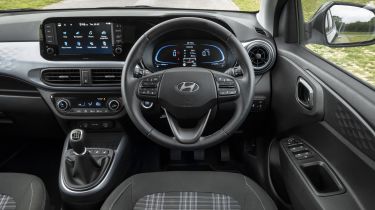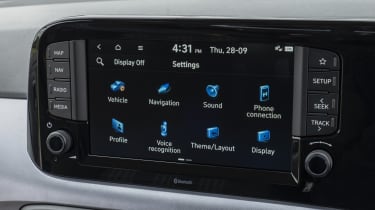Hyundai i10 - Interior, design and technology
Good levels of standard equipment and decent on-board tech, but the Hyundai i10 is too grey and dull inside

The styling of the i10 is modern, understated yet sharp. Hyundai gave its smallest offering a sportier profile thanks in part to a 20mm lowered stance and an increase of 20mm in overall width compared to the previous generation. In 2023, the i10 was given a subtle mid-life facelift with changes including new head and tail-light signatures, redesigned LED daytime running lights, a new grille and new alloy wheel designs.
As part of the recent facelift, the entry-level model previously called SE Connect was replaced by Advance trim. Standard kit includes 15-inch rims, a 4.2-inch display behind the leather-wrapped steering wheel, keyless entry, USB-C charging ports, an 8-inch touchscreen with wireless Apple CarPlay and Android Auto, rear parking sensors and a reversing camera. Safety features include collision avoidance assist, pedestrian detection, speed limit assist and lane assist.
The mid-range Premium trim (our pick of the bunch) brings 16-inch alloy wheels, bi-function headlights, tinted windows, heated front seats, tartan fabric seat upholstery with purple stitching, heated steering wheel, wireless smartphone charging pad and blue LED interior lighting.
The range-topping i10 N Line gets a boy racer look courtesy of a very aggressive face with a different grille and daytime running lights, plus a set of model-specific 16-inch alloy wheels and twin exhaust tips. There are plenty of red accents dotted around too, while some nice touches inside include brushed metal pedals, leather-wrapped gear knob, red stitching and bespoke N Line seats.
The i10’s leather-wrapped steering wheel hosts about the only soft touch material you’ll find inside the car. The rest of the interior is made from hard, scratchy black plastic, which we can accept in a car that starts at just over £15k, but it does make the cabin look and feel quite dull. The tartan or N Line seats liven things up a little, and the overall build quality feels solid.
Sat-nav, stereo and infotainment
Every i10 features an eight-inch touchscreen that’s relatively sharp and doesn’t take too long to respond to input. There’s also a handy bank of physical shortcut buttons on either side, along with a volume dial. The i10’s built-in infotainment system is limited, but wireless Android Auto and Apple CarPlay smartphone connectivity are standard-fit and fill the entirety of the screen nicely.
You can add sat-nav and Bluelink – Hyundai’s online system which gives drivers extra controls and features via a smartphone app – but we’d just save the £800 and stick to using Google Maps through the free smartphone connectivity.










